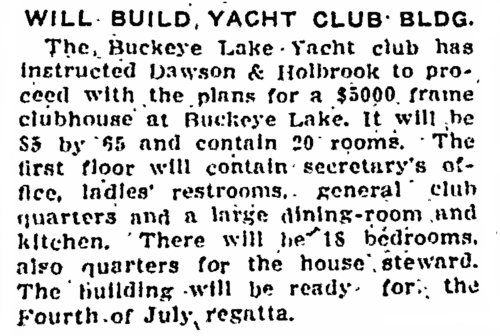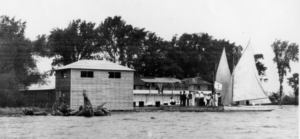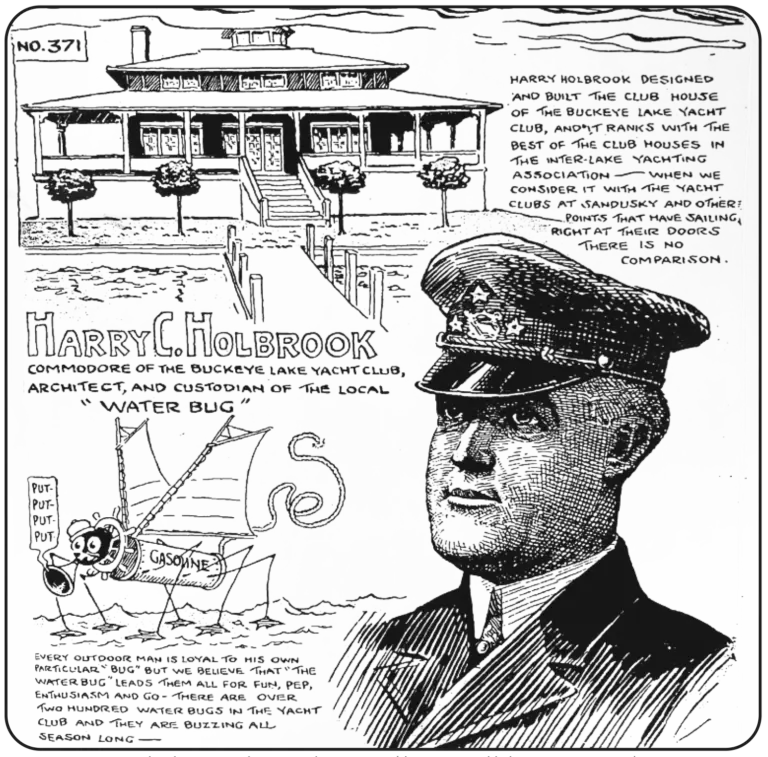– Commodore Steve Harris, BLYC Historian
April, 2023

BLYC is certainly known for our historic, old clubhouse. But few members, and even fewer visitors to the lake realize that this our second clubhouse.
When the club first formed in 1906, we were, in every sense, homeless. Not only did we not have a clubhouse, we didn’t even have a location on which to build one. Most of the club’s early regattas and events were held at members’ homes on Orchard Island or at the Lake Tourists Hotel on the south side of the lake. After a number of attempts to secure a land lease on waterfront property, the club settled on an area of “sometimes land, surrounded by always shallow water, and in springtime often flooded completely” known as “Sunken Island.” Sounds like the perfect place for a yacht club, doesn’t it?

Due to lack of funding, the first clubhouse was not the grandiose structure that the founding members had envisioned. It was, essentially, a small “locker room” over the water along the east side of the “island.” However, it served the members well for six years beginning in 1907 while efforts were undertaken to raise both the necessary funds and the island itself. It was during that time that two particularly important men were recruited to membership at BLYC – Harry D. Freeman, a Columbus real estate developer (and, incidentally, the developer of Harbor Hills years later) and Harry C. Holbrook, state architect and partner in the Columbus architectural firm of Dawson & Holbrook.
Harry Clyde Holbrook was born in Athens, Ohio in 1878. According to records from the American Institute of Architects, he began practice in 1895 – at the age of seventeen! His father died when he was a young child and the family relocated to Columbus. At age 14 he began working in the office of a prominent Columbus architect, later leaving to establish his partnershsip with architect Richard Dawson. He and Dawson designed many buildings throughout Ohio, primarily theaters and entertainment venues, and, of course, the BLYC clubhouse. His designs include the Midland Theater in Newark, the Palace Theater in Lancaster, the Clinton Theater in Clintonville, Chapman Theater in Columbus, Hughes Theater at Camp Perry, Fayette Theater in Washington Courthouse, King Hall at Otterbein College, the Coliseum and other structures at the Ohio State Fairgrounds, several Columbus office buildings, and a number of large, private homes throughout Columbus, including one near the OSU campus that now serves as the Delta Zeta Sorority House.
Joining BLYC in 1910, Holbrook was immediately active. His primary focus was, of course, the building of the “new” clubhouse. Plans were presented in February of 1912 and construction began in late June. That summer, July 4th festivities attracted a large crowd at the lake and the Club’s regatta was said to be the “chief entertainment” of the day. There were sixteen total events over the course of the day, highlighted by Holbrook’s new hydroplane – a form of craft developed only four years earlier and guaranteed to travel over the water at more than 35 mph.
By February, the clubhouse was essentially complete and was subsequently dedicated at the semiannual meeting on BLYC’s 7th “birthday,” May 6, 1913. That fall, Holbrook was elected to the Board of Governors and was immediately “jumped” to the office of Commodore for 1914. Holbrook served again as Commodore in 1915 and then as a Governor in 1916 and 1920 (possibly others – records are incomplete.) Commodore Holbrook passed away in December of 1946 and is buried in Greenlawn Cemetary in Columbus.
Along with Holbrook, there were many others who made our, now 110-year-old, clubhouse a reality. There are still others who worked to ensure that it was owned by us and under our control. Over the next few months, as we enter another season of change and improvement of our club home, I will endeavor to share their stories as well.

